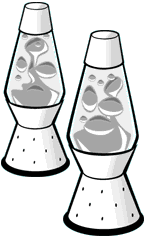|

Why does the oil float on the water?
Oil floats on water because a drop of oil is lighter than
a drop of water the same size. Another way of saying this is to say that
water is denser than oil. Density is a measurement of how much a given volume
of something weighs. Things that are less dense than water will float in
water. Things that are more dense than water will sink.
Even though oil and water are both liquids, they are what
chemists call immiscible liquids. That's a fancy word that means they don't
mix.
What happens when I pour salt on the oil?
Salt is heavier than water, so when you pour salt on the
oil, it sinks to the bottom of the mixture, carrying a blob of oil with
it. In the water, the salt starts to dissolve. As it dissolves, the salt
releases the oil, which floats back up to the top of the water.
 This looks like a
Lava Lite. How does a Lava Lite work?
This looks like a
Lava Lite. How does a Lava Lite work?
Like your oil and water, the "lava" in a Lava
Lite doesn't mix with the liquid that surrounds it. When it's cool, the
"lava" is a little bit denser than the liquid surrounding it.
When the "lava" rests on the bottom of the Lava Lite, the light
bulb in the lamp warms it up. As it warms up, the "lava" expands
a little. When it expands, the "lava" stays the same weight but
it takes up more space-so it's less dense. When it's warm enough, the "lava"
is less dense than the surrounding liquid, and so it rises up to the top
to float. At the top of the lamp, it cools down, becomes more dense, and
sinks once again. This cycle repeats over and over as the "lava"
warms up and rises, then cools down and sinks.
Where did this experiment come from, anyway?
Exploratorium Teacher-in-Residence Eric Muller created
this activity while playing with his food in a Chinese restaurant.
|